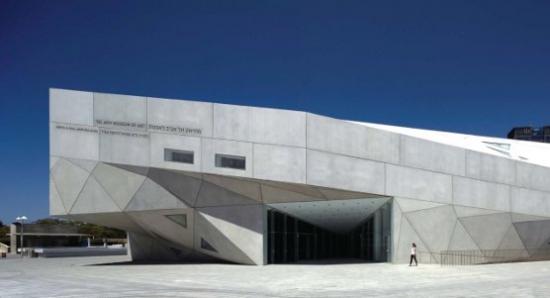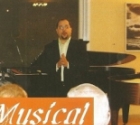
If you've visited the Tel Aviv Museum of Art recently, you'll have noticed that there's a bonus: access to the dazzling Herta and Paul Amir Building, which adds some 195,000 square feet of space to the museum. This iconic new landmark for the city's cultural center complements the nearby Beit Ariela municipal library, and the Golda Meir Center which encompasses the Israel Opera and the Cameri Theater.
The building is sited on a triangular lot. In shape, a parallelogram in concrete, glass and stone, it has precast curved forms on its outside and Israel’s largest exhibition gallery within. Inside, the galleries are built around a spiraling, top-lit 87 foot high structure named the Lightfall, which has twisting surfaces of hyperbolic parabolas that curve around the structures and allow natural light to flow through the five levels, two above ground level and three below. Diagonal ramps zigzag from one level to another like a kind of architectural art work. The whole aim, according to American architect Preston Scott Cohen, is not only to provide optimal flexible space for art, but also to offer an aesthetic and social experience in itself.
The building was nine years in the planning and construction, and has been the focus of much discussion about the role of a major art gallery today. Should it simply provide neutral housing for the art it displays? Or should it be a spectacle in itself, on the same level as the art? Form or function, or both?
Preston Scott Cohen aimed for a combination of the two, but not everyone agrees that he has succeeded.
The building has been called "visionary", "unprecedented" and a "landmark", among other superlatives. It has been hailed as having the potential to alter the future of museum architecture and lift Israel to new prominence in the world of contemporary art. And indeed, the structure is certainly impressive and inspiring, both inside and out. Personally, I loved it. But not everyone does.
Esther Zandberg, Haaretz's influential architecture critic, had plenty to say, none of it good. In a long article titled "What a Splendid Waste", she criticizes the absence of orientation in the museum which results in confusion, clash between the outside shell and interior space, forced spaces, broken levels and fragmented ceilings and much else. The central motif, the Lightfall, is in her view, a spectacular architectural image empty of content. "Where is the child," she asks, "who will point out that the emperor has too many clothes and they don't match?"
Above all, she bemoans the fact that the city of Tel Aviv chose the design of their new museum to mimic the "Bilbao Effect" – the type of architecture seen in structures like the Guggenheim Museum in Bilbao, Spain, designed by Frank Gehry, which aims for "wow" and spectacle rather than for serving the public.
Once she gets wound up, Zandberg really lets the museum's initiators have it: the new breed of architecture is intended to "glorify the name and power of local politicians, CEOs and wealthy donors" and as for the Lightfall, this "hyperbolic totem didn't work....At least it photographs nicely." Ouch.
In contrast, she believes, the adjoining "old" museum, built in 1971, is one of the most successful museums of its time. In her opinion a model of compatibility between space and material, form and content, time and place, it has no motif at all; instead it has spirit of life and is inviting, simple and elegant.
Zandberg is not the new museum's only detractor. The Lightfall atrium was mocked by Haaretz columnist Alon Idan, who wrote in an amusing article that it reminded him of the Dizengoff Center mall. He sees in both the same kind of Kafka-esque labyrinth ranged around an abyss in which the visitor gets lost: "you start from one point, but can't be sure that you're going to return to it in the end."
Tel Aviv architect Assaf Diamond agrees that the museum extension is out of context in design, "like a UFO landed in Tel Aviv" but that is not necessarily a bad thing. "Modern architecture gives less attention to context than to new techniques and materials. I think it's very successful. It's a statement of what modern architecture is all about. I'm for it!"
So is the new building Tel Aviv's pride and joy, or a $50 million mistake? We will have to decide for ourselves.
 That Certain Smile
That Certain Smile Fay Shelter 1919-2012
Fay Shelter 1919-2012 Doreen (Devorah) Goldberg 1924 – 2012
Doreen (Devorah) Goldberg 1924 – 2012 Art from the Heart
Art from the Heart Jewish Art Returns to Jerusalem
Jewish Art Returns to Jerusalem Musical Treats
Musical Treats Carol Novis
Carol Novis